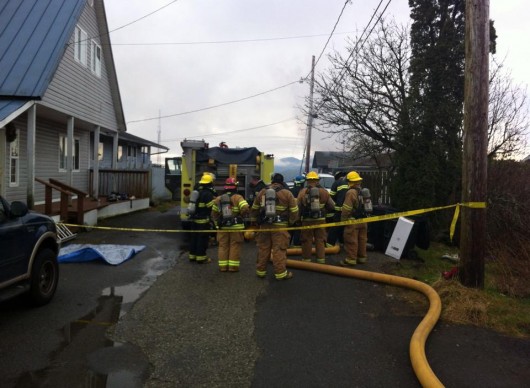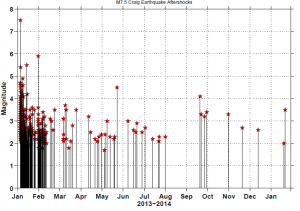
Firefighters gather in the Grant Street parking lot to plan their strategy this summer in response to a residential fire on Edmonds Street, a boardwalk stair street in downtown Ketchikan.
The Chief Executive Officer of the American Red Cross of Alaska visited Ketchikan this week as part of a tour of Southeast communities. He talked to the Ketchikan Chamber of Commerce about the services that Red Cross provides, and the importance of volunteers in rural communities.
Tanguy Libbrecht said that Alaskans everywhere need to be ready.
“How likely to have another 8.1 magnitude quake, like we did in 1949? Or the earthquake or tidal wave that affected Craig and almost wiped out Craig’s infrastructure years ago? Or the 1964 quake that so affected the state, or the 4.8 quake that was in Haines this morning?” he said. “Things are moving, things are shaking.”
Libbrecht said Red Cross offers all kinds of services to help people help themselves and be ready for disaster. For example, there’s an earthquake app that can alert subscribers whenever there’s seismic activity nearby.
“Although, I highly recommend setting the filter on that above a 4-point-something because otherwise it will go off in your pocket every two minutes,” he said. “Because there are literally hundreds of earthquakes that happen a month in Alaska. Took me a while to figure that out.”
That app is available through mobile app stores, along with a bunch of others you can find by searching for “Red Cross.” Some examples are apps that help people make a disaster plan, gather materials for an emergency kit or perform first aid for their pets.
A big service that Red Cross provides is assistance to families affected by home fires. Statewide, the Red Cross responds to about 200 home fires per year.
Roger Rettig is the Southeast Disaster Response Specialist, based in Juneau. He talked
about a five-year campaign to reduce the numbers of people hurt or killed by home fires.
“House fire is the single most death and injury event, and it happens all too frequently,” he said. “In 2013, it was 16, and so far to date in 2014, nine. Nine deaths (from house fires), just this year alone in the state.”
The home fire prevention campaign focuses largely on providing smoke detectors. Rettig said people have about two minutes to get out of a burning building before they’ll be overcome by smoke. Smoke detectors provide an early alert to maximize that opportunity, and Red Cross wants to get as many smoke detectors into homes as possible.
“We’re talking a door-to-door campaign: Pick a community, go with a fireman, go with a Red Cross volunteer,” he said. “Maybe it’s a Boy or Girl Scout troop, maybe it’s a condominium owner or home neighborhood association. Whoever we can partner with to do this campaign over the period of five years.”
Community partners and volunteers are important to the Red Cross and its ability to provide services. The Red Cross of Alaska covers the entire state with a paid staff of just 14 people. Libbrecht said that small staff is supported by about 540 volunteers in communities throughout Alaska.
But, there currently are no Red Cross volunteers in Ketchikan. And while the organization can provide services without a local coordinator, he says it’s much easier with a designated volunteer in a community.
More information about Red Cross and how to volunteer is available online at www.redcross.org/Alaska






